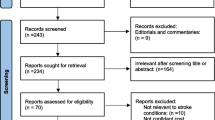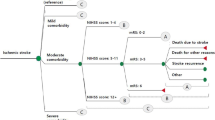Abstract
Objective
To evaluate the cost-effectiveness of combining Chinese medicine (CM) with Western medicine (WM) for ischemic stroke patients.
Methods
Hospitalization summary reports between 2006 and 2010 from eight hospitals in Beijing were used to analyze the length of stay (LOS), cost per stay (CPS), and outcomes at discharge.
Results
Among 12,009 patients (female, 36.44%; mean age, 69.98±13.06 years old), a substantial number of patients were treated by the WM_Chinese patent medicine (CPM)_Chinese herbal medicine (CHM) (38.90%); followed by the WM_CPM (32.55%), the WM (24.26%), and the WM_CHM (4.15%). With adjustment for confounding variables, LOS of the WM_CPM_CHM group was about 10 days longer than that of the WM group, and about 6 days longer than that of the WM_CPM group or the WM_CHM group (P<0.01); CPS of the WM_CPM_CHM group was United States dollar (USD) 1,288 more than that of the WM group, and about USD 600 more than that of the WM_CPM group or the WM_CHM group (P<0.01). Compared with the WM group, odd ratio (OR) of recovered and improved outcome of the WM_CPM_CHM group was the highest [OR: 12.76, 95% confidence intervals (CI): 9.23, 17.64, P<0.01], OR of death outcome of the WM_CPM_CHM group was the lowest (OR: 0.08, 95% CI: 0.05, 0.12, P<0.01). There was no significant difference between LOS, CPS and OR of the WM_CPM group and those of the WM_CHM group (P>0.05). Cost/effectiveness and incremental cost-effectiveness ratio of the WM_CPM_CHM group were robustly higher than those of the WM group.
Conclusion
Compared with WM alone, supplementing CPM and CHM to WM provides significant health benefits of improving the chance of recovered and improved outcome, and reducing the death rate, at an expense of longer LOS and higher CPS.
Similar content being viewed by others
References
Bonita R, Mendis S, Truelsen T, Bogousslavsky J, Toole J, Yatsu F. The global stroke initiative. Lancet Neurol 2004;3:391–393.
Feigin VL. Stroke epidemiology in the developing world. Lancet 2005;365:2160–2161.
Ministry of Health of the People’s Republic of China. China’s health statistics yearbook, 2011. Beijing: Peking Union Medical College Press; 2011:290,329.
Roger VL, Go AS, Lloyd-Jones DM, Benjamin EJ, Berry JD, Borden WB, et al. Heart disease and stroke statistics—2012 update: a report from the American Heart Association. Circulation 2012; 125:e2–e220.
Adams HP Jr, del Zoppo G, Alberts MJ, Bhatt DL, Brass L, Furlan A, et al. Guidelines for the early management of adults with ischemic stroke: a guideline from the American Heart Association/American Stroke Association Stroke Council, Clinical Cardiology Council, Cardiovascular Radiology and Intervention Council, and the Atherosclerotic Peripheral Vascular Disease and Quality of Care Outcomes in Research Interdisciplinary Working Groups: The American Academy of Neurology affirms the value of this guideline as an educational tool for neurologists. Circulation 2007;115:478–534.
Chinese Medical Association Neuropathy Credits. Acute ischemic stroke diagnosis and treatment guildelines in China. Chin J Neurol (Chin) 2010;43:146–153.
European Stroke Organisation. Guidelines for stroke management (2008). Available at http://www.eso-stroke.org/recommendations.php. Accessed on June 1, 2012.
Hankey GJ. Neuroprotection for acute ischemic stroke: hope reignited. Lancet Neurol 2006;5:287–288.
Lapchak PA, Araujo DM. Advances in ischemic stroke treatment: neuroprotective and combination therapies. Expert Opin Emerg Drugs 2007;12:97–112.
Dirnagl U. The bad begins and worse remains behind: systemic effects of stroke as target for brain protection. Int J Stroke 2010;5:48.
Shi FL, Hart RG, Sherman DG, Tegeler CH. Stroke in the People’s Republic of China. Stroke 1989;20:1581–1585.
Jiang M, Yang J, Zhang C, Liu B, Chan K, Cao HX, et al. Clinical studies with traditional Chinese medicine in the past decade and future research and development. Planta Med 2010;76:2048–2064.
Liu M, Wu B, Wang WZ, Lee LM, Zhang SH, Kong LZ. Stroke in China: epidemiology, prevention, and management strategies. Lancet Neurol 2007;6:456–464.
Wang NL, Liou YL, Lin MT, Lin CL, Chang CK. Chinese herbal medicine, Shengmai San, is effective for improving circulatory shock and oxidative damage in the brain during heatstroke. J Pharmacol Sci 2005;97:253–265.
Wu B, Liu M, Liu H, Li W, Tan S, Zhang S, et al. Metaanalysis of traditional Chinese patent medicine for ischemic stroke. Stroke 2007;38:1973–1979.
Cheng H. Scientific and cost-effect analysis of free fried pieces of Chinese medicine formulations. Capit Med (Chin) 2000;7:29–31.
Feigin VL. Herbal medicine in stroke: does it have a future? Stroke 2007;38:1734–1736.
Fønnebø V, Grimsgaard S, Walach H, Ritenbaugh C, Norheim AJ, MacPherson H, et al. Researching complementary and alternative treatments—the gatekeepers are not at home. BMC Med Res Methodol 2007;7:7.
Li AJ, Chen X. People’s doubt on traditional Chinese medicine granules. Capit Med (Chin) 2010;1:28–29.
Quintard H, Borsotto M, Veyssiere J, Gandin C, Labbal F, Widmann C, et al. MLC901, a traditional Chinese medicine protects the brain against global ischemia. Neuropharmacology 2011;61:622–631.
Tang JL, Leung PC. An efficacy-driven approach to the research and development of traditional Chinese medicine. Hongkong Med J 2001;7:375–380.
Chang YP, Xie YM. Overview of pharmacoeconomic studies on traditional Chinese medicines and Western medicines in treatment of stroke. China J Chin Mater Med (Chin) 2012;37:3509–3512.
Rao ML. China guideline for cerebrovascular disease prevention and treatment. Beijing: People’s Medical Publishing House; 2007:46–47.
Zhu HF, Newcommon NN, Cooper ME, Green TL, Seal B, Klein G, et al. Impact of a stroke unit on length of hospital stay and in-hospital case fatality. Stroke 2009;40:18–23.
Somerford PJ, Lee AH, Yau KK. Ischemic stroke hospital stay and discharge destination. Ann Epidemiol 2004;14:773–777.
Palnum KD, Andersen G, Ingeman A, Krog BR, Bartels P, Johnsen SP. Sex-related differences in quality of care and short-term mortality among patients with acute stroke in Denmark: a nationwide follow-up study. Stroke 2009;40:1134–1139.
George MG, Tong X, Kuklina EV, Labarthe DR. Trends in stroke hospitalizations and associated risk factors among children and young adults, 1995–2008. Ann Neurol 2011;70:713–721.
Tao ZR. Reliability, validity and sensitivity of Chinese scale for clinical neurological deficit of stroke patients. Acad J Second Milit Med Univ (Chin) 2009;30:283–285.
Goldstein LB, Samsa GP, Matchar DB, Horner RD. Charlson index comorbidity adjustment for ischemic stroke outcome studies. Stroke 2004;35:1941–1945.
Tirschwell DL, Kukull WA, Longstreth WT. Medical complications of ischemic stroke and length of hospital stay: experience in Seattle, Washington. J Stroke Cerebrovasc Dis 1999;8:336–343.
Arnold RJG. Pharmacoeconomics: from theory to practice. Boca Raton, FL: CRC Press; 2010:163–173.
Liu MY, Chen KJ. Convergence: the tradition and the modern. Chin J Integr Med 2012;18:164–165.
Wang XJ, Sun H, Zhang AH, Sun WJ, Wang P, Wang ZG. Potential role of metabolomics approaches in the area of traditional Chinese medicine: as pillars of the bridge between Chinese and Western medicine. J Pharm Biomed Anal 2011;55:859–868.
Yang YH. Application principles of Chinese patent medicines and analysis of irrational drug use. Clin Med J (Chin) 2009;7:36–38.
Liu SL, Liu MF, Zhu BL. Study Progress on Chinese herbal medicine components with activity against ischemic stroke. Med Recapitul (Chin) 2009;15:3478–3480.
Tsang I, Huang S, Koehler B. Integration of Chinese medicine and Western medicine in clinical practice (patient care): past, present, and a proposed model for the future. Chin J Integr Med 2013;19:83–85.
Lamb J, Crawford ED, Peck D, Modell JW, Blat IC, Wrobel MJ, et al. The connectivity map: using gene-expression signatures to connect small molecules, genes, and disease. Science 2006;313:1929–1935.
Zimmermann GR, Lehár J, Keith CT. Multi-target therapeutics: when the whole is greater than the sum of the parts. Drug Discov Today 2007;12:34–42.
Diringer MN, Edwards DF, Mattson DT, Akins PT, Sheedy CW, Hsu CY, et al. Predictors of acute hospital costs for treatment of ischemic stroke in an academic center. Stroke 1999;30:724–728.
Gillum LA, Johnston SC. Characteristics of academic medical centers and ischemic stroke outcomes. Stroke 2001;32:2137–2142.
Holloway RG, Witter DM Jr, Lawton KB, Lipscomb J, Samsa G. Inpatient costs of specific cerebrovascular events at five academic medical centers. Neurology 1996;46:854–860.
He J, Kwon Y, Li C, Zhang XQ, Zhao JG. Several considerations in using traditional Chinese patent medicine for cerebral infarction. Chin J Integr Med 2012;18:571–574.
Patsopoulos NA. A pragmatic view on pragmatic trials. Dialogues Clin Neurosci 2011;13:217–224.
Lu AP, Chen KJ. Integrative medicine in clinical practice: from pattern differentiation in traditional Chinese medicine to disease treatment. Chin J Integr Med 2009;15:152.
Lu AP, Bian ZX, Chen KJ. Bridging the traditional Chinese medicine pattern classification and biomedical disease diagnosis with systems biology. Chin J Integr Med 2012;18:883–890.
Author information
Authors and Affiliations
Corresponding author
Additional information
Partly supported by the “985” Project from Ministry of Education of China (No. BMU20100107)
Rights and permissions
About this article
Cite this article
Li, Y., Xi, Hx., Zhu, S. et al. Cost-effectiveness analysis of combined Chinese medicine and Western medicine for ischemic stroke patients. Chin. J. Integr. Med. 20, 570–584 (2014). https://doi.org/10.1007/s11655-014-1759-9
Received:
Published:
Issue Date:
DOI: https://doi.org/10.1007/s11655-014-1759-9




